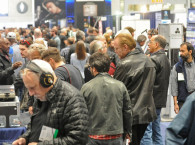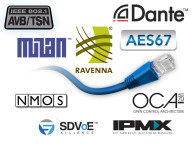You can call it the “rtf” format or the neutral “Switzerland” of audio networking. The AES67 open format is here and the demonstrations at ISE 2016 reflected the growing importance of network interoperability in AV. Several initiatives promoted by the Media Networking Alliance (MNA) at this show served to demonstrate how important this will be for audio in general.
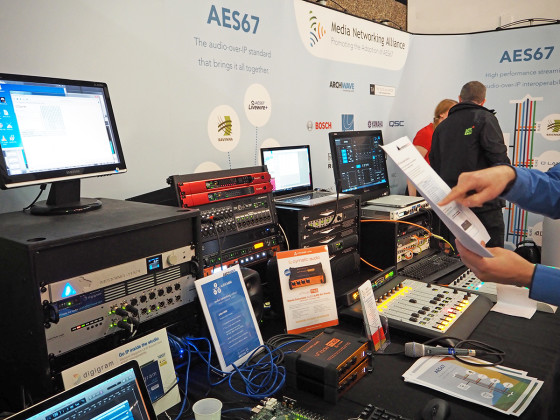
With the ever-increasing pace of adoption of IP based networking in AV, there is a mounting lobby for standardization and interoperability based on open standards. Consequently, the Media Networking Alliance (MNA) – the professional AV industry alliance, charged with promoting awareness and adoption of AES67, the open standard that provides for the common interchange of digital media between different IP networking platforms – promoted a strong series of initiatives at the ISE 2016 show.
And the fact that now there are actual products being released commercially which support AES67 - like Genelec’s new 8430 IP Network Compatible SAM Studio Monitor - is a clear indicator of how important this simple but effective “universal” audio networking exchange format is going to be. AES67 allows for the industry to gain confidence on the compatibility of dominant audio networking technologies, allowing systems based on Dante, Ravenna, Livewire or QSC’s Q-LAN to effectively exchange audio, while allowing manufacturers of products which do not require the full set of functionalities allowed by those protocols - such as speakers - to introduce network connectivity options in their newest products, with total confidence.
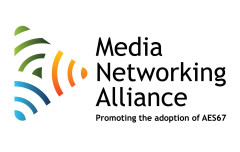 At ISE 2016, MNA members and member manufacturers promoted a program of educational and communication activities and events throughout the exhibition. Repeating the initiative originally organized at the 139th AES Convention in New York, this time especially targeted at AV manufacturers, integrators and end users alike, was a live demonstration of audio networking interoperability on the MNA booth, featuring 22 commercially available networked-audio products from 11 different manufacturers, employing various market leading audio networking technologies.
At ISE 2016, MNA members and member manufacturers promoted a program of educational and communication activities and events throughout the exhibition. Repeating the initiative originally organized at the 139th AES Convention in New York, this time especially targeted at AV manufacturers, integrators and end users alike, was a live demonstration of audio networking interoperability on the MNA booth, featuring 22 commercially available networked-audio products from 11 different manufacturers, employing various market leading audio networking technologies.AES67-specific extensions to the different network platforms enable the common interchange of digital audio between them and served to demonstrate how simple and effective this connectivity can be, with all the benefits of a network setup. The demonstration featured products from ALC NetworX, Archwave/Cymatic Audio, Axia Audio, Digigram, DirectOut, Focusrite, Lawo, Merging Technologies, QSC, Solid State Logic, Telos Systems, and Yamaha, between them employing Dante, Livewire, Q-LAN and Ravenna AoIP protocols.
There was a mixture of hardware devices, software products and hardware development kits, with the predominance of hardware products reflecting the accelerating trend of manufacturers readily enabling AES67 in existing network devices. Primarily a multicast demonstration, devices were connected to a simple network with a single Ethernet switch; high quality audio in AES67, was “transported” via Ethernet and layer 3 network connectivity, which effectively can be any VoIP capable network infrastructure.

Particularly interesting in the MNA demonstration where two Cymatic Audio uNode M42 devices, which are remote controllable AudioLan Mic Preamps with four microphone/line inputs, two line outputs and MIDI, allowing for simple audio interfaces with Ravenna/AES67 networks. The uNode M42 devices, which will be available Summer 2016, allow using microphones, line-level sources, and MIDI devices with any AES67 or Ravenna equipped audio mixing console or sound installation. Very simple to use and configure, they will be at home in recording studios, live sound as well as install environments, since they can be used as modules. It’s possible to mix and match multiple uNode M42 units as needed, at any physical locations and they are designed to be free-standing on a stage floor or mounted securely in a rack.
In the MNA demonstration, the Cymatic uNode M42 devices - like any other equipment connected in the demonstration - could send audio to a pair of IP Network connected Genelec speakers, in this case 4010A active installation speakers prototypes with Ravenna/AES67 support, which have been used in previous demonstrations.
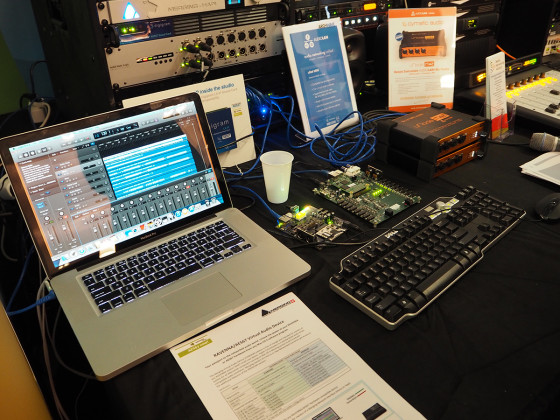
Also, important to note that several Dante solutions were included in the demonstration and were showing sending and receiving audio from other AES67-capable devices operating on the same network. This was possible following the release of a firmware update that provides support for the AES67 audio networking standard for products based on Audinate’s Dante Brooklyn II card. This confirms that the addition of AES67 allows baseline connectivity between the growing ecosystem of Dante-enabled devices and networked devices from other vendors who support AES67 bridging. The MNA demonstration also highlighted the fact that AES67 only covered the basic sync, QoS and transport of networked audio. Additional important functionalities like device discovery, channel naming, clock monitoring, network status, latency monitoring, and redundancy are provided by the complete feature set of the equipment solutions, such as Dante, Ravenna, Livewire or Q-LAN.

Speaking for the MNA, Solid State Logic product manager Tom Knowles, coordinating the demonstration at ISE, said, “Following on from our first public demonstration at last year’s AES show, the MNA believes it is important and impressive to demonstrate interoperability at trade shows and in other “public” arenas, enabling manufacturers and potential end users to experience, first hand, the power and versatility of AES67.”
In addition to audio transport, some of the manufacturer-specific discovery, control and monitoring functions, that augment AES67 audio interoperability and coexist on the same network, were demonstrated. Also, throughout ISE, representatives from member companies with extensive experience of deploying AES67 were at hand to discuss all aspects of AES67 implementation.
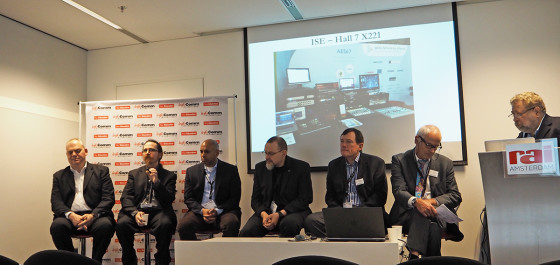
How Will AES67 Affect the Industry?
On Wednesday February 10, Rich Zwiebel MNA Chairman and Vice President, Systems Strategy QSC, moderated the session “How Will AES67 Affect the Industry?”, an open discussion with a panel of network audio specialists from Merging Technologies, Yamaha, Archwave, Bosch, Shure and Genelec. The session was an informative exchange on media networking and the role of open standards in the development of an interoperability eco-system.
With Rich Zwiebel - the founder of Peak Audio and CobraNet - the session included Claude Cellier, President & CEO of Merging Technologies, one of the most important companies in the design and architecture of Ravenna/AES67 AoIP Networked Audio converters; Arie van den Broek, Chief Executive Officer Archwave, the Swiss based specialist in pro-audio media networking processors for PC audio connectivity; Terry Holton, General Manager of the Yamaha R&D Centre in London; Ethan Wetzell, Platform Strategist Bosch Communications Systems, an active participant in standards activities such as AES67 and AES70, having worked with the AVnu Alliance, Media Networking Alliance, and OCA Alliance; Bob Abraham, Director Digital Audio Products at Shure Incorporated; and Aki Mäkivirta, R&D Director at Genelec.
The session included multiple interventions which served to illustrate the benefits and the challenges of the new AES67 standard. But all panelists were enthusiastic about the perspectives for the audio industry and the clear benefits this awards. Claude Cellier was the most optimistic, stating that he believes AES67 will endure in the industry for “the next 25 years.”
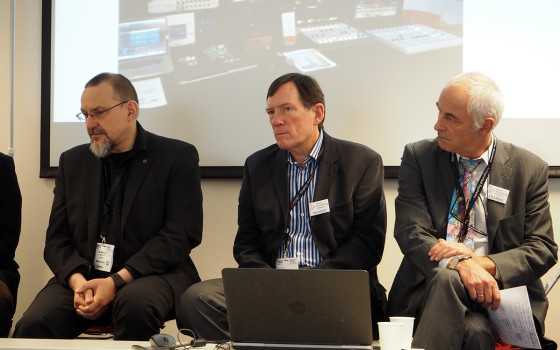
Asked specifically about the benefits of AES67, Aki Mäkivirta, R&D Director at Genelec, provided a concise explanation of what the company responsible for the world’s first commercially-ready AoIP (Audio over Internet Protocol) network compatible speaker sees as the main motivations. “This is going to add flexibility for the client/user. He will have a better selection of competing products to deliver the service and more security when investing in this sort of technology. He can also trust that the system he is purchasing is going to perform flawlessly. I believe also that the lifetime of these investments will improve.”
More broadly speaking in terms of AoIP and networked audio systems - the panel tended to discuss the broader picture, instead of specifics for AES67 - all interventions considered reducing cabling has one of the main considerations. Aki Mäkivirta specifically mentioned the experience of the IP-based studio concept turned reality by the European Broadcasting Union (EBU) and Belgian public broadcasting company VRT. An all-IP project featuring a multi-vendor system, using only open standards such has SMPTE 2022/6, AES67, and PTP – to transport broadcast feeds over an IP network. “This was the single most important thing that they found out. Everybody loved the system afterwards. Before they felt they didn’t understand what was going on in there, so they were afraid. Once they actually started recording program material with this new concept and they figured that there’s a single cable type connecting the whole studio, and to another facility, they found that reducing cabling was the single most important benefit.”
“Yes, we do have the audio signal available from the microphone to the loudspeaker in this networked environment. This gives us the maximum flexibility and the maximum benefit for the investment. It gives us full control of a facility, so that we can modify the way we operate within the facility. All these things are advantages”, added Genelec’s R&D Director.
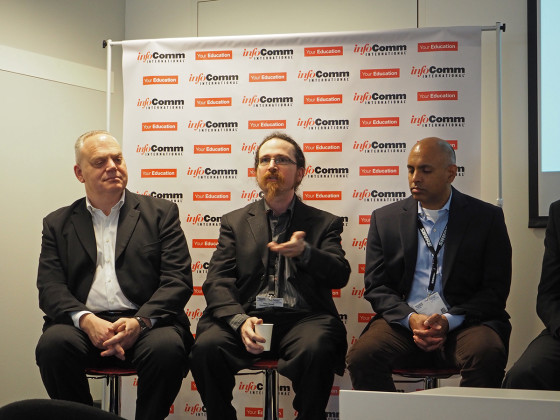
Product demonstrations
In addition to the Media Networking Alliance’s (MNA) own debut presence at ISE, featuring an extensive live AES67 interoperability demonstration, several of the alliance’s member companies had their own live AES67 demonstrations; illustrating the power and versatility, and accelerating rate of adoption of the audio-over-IP streaming interoperability open standard.
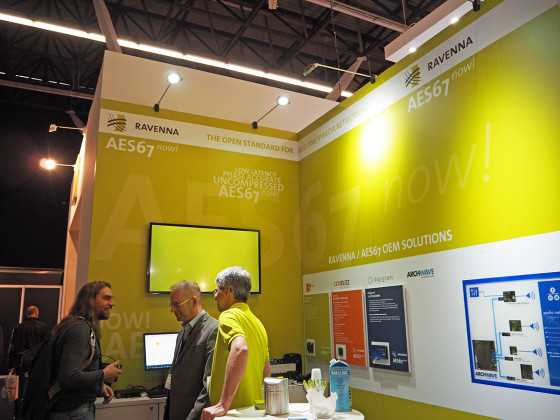
On the Ravenna booth, Archwave demonstrated its AudioLan networking solutions, offering Ethernet audio networking via an AES67/ Ravenna compliant web interface, with optional support for CopperLan and Ember+. Archwave modules convert standard format digital audio streams to AES67/Ravenna compliant IP audio streams as standard. The company offers a wide range of OEM Audio Networking Solutions, including the new 2+2 channel uNET MINI for end-point applications.
As reported, Genelec debuted its Ravenna/AES67 network enabled 8430 speaker, a brand new addition to the Smart Active Monitor (SAM) range of products and the world’s first commercially-ready AoIP (Audio over Internet Protocol) studio monitor. In addition, the loudspeaker company, together with Jutel, showcased a high quality, multi-zoned, fully LAN based installed AV system; with audio streamed directly to loudspeakers via AoIP and Ravenna.
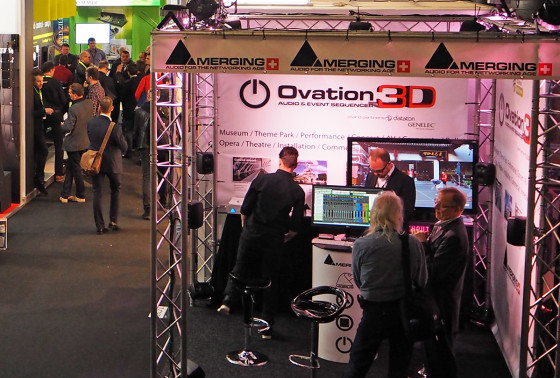
Merging Technologies, presented an immersive audio over IP demonstration with the company’s Ovation Audio Server/Sequencer driving an 18 speaker array of Genelec’s pre-production Ravenna/AES67 network enabled 4420 model. The Ravenna/AES67 networked installation served to demonstrate the flexibility of the system and the simplicity of the cabling infrastructure.
In a very positive development, Merging has also announced the release of a new CoreAudio driver that is available to the whole AES67 community. This driver, dubbed Ravenna/AES67 Virtual Audio Device, is fully compliant with Ravenna and other AES67 compatible devices and provides an easy way for Mac users to connect to the majority of available Networked Audio Devices. The Virtual Audio Device will be a Free Of Charge download from the Merging website and will support full operation of up to 64 channels in and out at 44.1/48kHz. It can be expanded to the fully featured Premium licensed version with support for sampling frequencies up to 384kHz and DSD256. (Windows drivers are available commercially from Merging and ALC NetworX and there is the free Ravenna Virtual Sound Card for Windows available here)
Also at ISE 2016, Lawo demonstrated an AES67 setup including the Lawo mc²36 all-in-one audio console and Lawo’s latest IP video & audio routing and processing solutions. The IP products include V_line I/O units for video and A_line I/O units for audio, as well as network-based processing and mixing engines, such as the 19”/1RU Compact Engine.
AES67-2015 Standard
www.medianetworkingalliance.com





